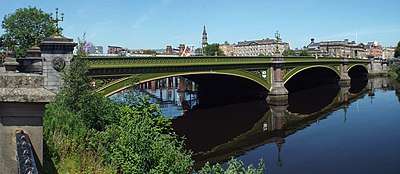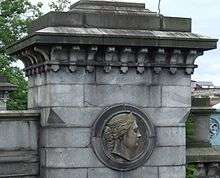Albert Bridge, Glasgow
Albert Bridge is a road bridge spanning the River Clyde in Glasgow, Scotland near to Glasgow Green. The bridge, opened in 1871, links the Saltmarket in the city centre with Crown Street on the southside, is category A listed, and named after Queen Victoria's consort, Prince Albert.

Previous Bridges
Albert Bridge is the fifth bridge to be built on the site in Glasgow. The first bridge on the site was built in 1794 and was known as Hutcheson Bridge but was destroyed by flooding in 1795. A timber footbridge replaced it in 1803, and in 1834 a masonry arch bridge was designed by Robert Stevenson, grandfather of Robert Louis Stevenson.[1]
Stevenson's bridge was demolished in 1868 and replaced with a temporary wooden bridge until 1871,[1] when the current Albert Bridge was constructed.
Construction

After investigating the old bridge, the Bridge Trustees agreed to a total removal of the old bridge. A new more elegant and more convenient bridge would be substituted for it. A budget of £39,000 was secured, and Bell & Miller Engineers from Glasgow were charged to make a design. A subsequent tender for building the bridge to their first specifications did not receive a bid lower than £54,000. Therefore, Bell & Miller were ordered to make a new design. After making some changes to the structural features of the work, a new bid for £48,000 came in. The contractors were Hanna, Donald & Wilson from Paisley, Scotland.[2]
Albert Bridge is founded on concrete piers and abutments filled with cast iron caissons, sunk some 86 ft below water level. Traditional masonry was rejected in favour of rivetted wrought iron elliptical arches, the largest of which spans 114 ft. The arch ribs are masked by cast iron spandrels adorned with the Royal coat of arms, the coat of arms of Prince Albert and those of various corporate bodies. The stone pillars supporting the parapet are decorated with medallions of Queen Victoria and Prince Albert by the Scottish sculptor George Edwin Ewing.
The bridge carries the eastern arm of the A8 across the River Clyde. It is two way with 2 lanes and it is complemented by the Victoria Bridge on the other side of the railway bridge, which is one-way northbound.
A£3.4 million refurbishment programme began in 2015 and was recognised by a visit from The Earl of Wessex on 13 October 2016.[1]
References
- Maw, Henry (1872), Modern Examples of Road and Railway Bridges, Offices of 'Engineering', London
Notes
- "Albert Bridge receives Royal recognition for restoration". Glasgow City Council. Retrieved 21 April 2018.
- Maw 1872, p. 27.
| Wikimedia Commons has media related to Albert Bridge, Glasgow. |
| Next crossing upstream | River Clyde | Next crossing downstream |
| Pipe Bridge and Weir | Albert Bridge | City Union Bridge |